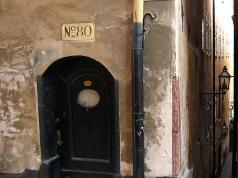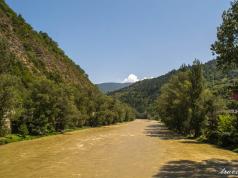Caves and grottoes
Archeology
Story
Excursions to the White Rock
If you noticed an inaccuracy or the data is outdated - please correct it, we will be grateful. Let's create the best encyclopedia about Crimea together!
A vertical white rocky wall rises above the valley of the Biyuk-Karasu River and is visible long before approaching it at a distance of a kilometer. The height of the peak above sea level is 325 m, and the height difference between the valley and the top of the cliff reaches 100 m.
The bulk of the rock resembles an impregnable fortress and is better visible from its southern side. The rock is a symbol of Belogorsk.
Over many millennia, the sun, water and wind have done their job, forming bizarre shapes that were formed in the process of weathering and destruction by water and temperature changes. Especially on the western wall of the rock, the so-called eolian grottoes, formed under the influence of winds, stand out.
Caves and grottoes
Of particular interest are the caves of Ak-Kaya - lower and upper. The lower cave is a grotto in the middle of the western wall - Bob. Signs belonging to the Sarmatians who lived here in the first centuries of our era were found on its walls. It is believed that once this cave was a sanctuary - an ancient temple. The upper cave - which means "Golden Burrow" in translation - over the years has acquired legends and traditions. The cave is difficult to access: the entrance to it in the form of a round hole is located 52 meters from the sole and 49 meters from the edge of the cliff.
Archeology
The cave is especially curious for archaeologists, because they managed to establish that many thousands of years ago it was the habitat of an ancient man. Ak-Kaya served him both as a shelter from bad weather and as a corral during the hunt for animals (according to excavations in the 1960s).
In one of their expeditions, four sites of primitive man of the Mousterian era (100-40 thousand years ago) were partially excavated. Interested archaeologists will be interested in the book by Yu. Kolosov "White Rock", Ed. Tavria, 1977. The author describes in detail how cultural layers with a mass of materials were found, how for the first time in the territory of the former country a Neanderthal skull and other rare and valuable finds for science were found, proving that civilization arose not only in Europe, but also on our territory.
Story
It is believed that Ak-Kaya was a place of execution in the Middle Ages. There is a legend that the young Bohdan Khmelnitsky, who was captured in 1620, was twice brought to this rock, and the captives were thrown in front of him in order to force Bogdan to hurry up with a ransom.
During the Russian-Turkish wars, the headquarters of A. V. Suvorov was located in these places. On the White Rock, the result of the centuries-old struggle of the Russian state for the Crimea was summed up. It was here that on June 10, 1783, Prince G. A. Potemkin ordered the Crimean beys and murzas to appear in order to take their oath of allegiance to the Russian state.
Excursions to the White Rock
And Ak-Kaya is also good because it offers an awesome view of the mountain range in the south and the endless steppe expanses with ridges of ancient barrows in the north. And how beautiful it is in May, when peonies bloom. It becomes clear why the beam located to the north of the rock is called Red. And how does the Kalliston pass look from here, which lies in the south between the two cone-shaped mountains Shuvri and Khrikol!
I recommend climbing the rock in the late afternoon. It’s not hot anymore, the lighting is soft, the distances open up for observation. For those who like to explore all the holes, I recommend walking along the path that runs under the very rocks on the western side of the cliff. This trail will take you to the lower grotto and take great pictures, especially at sunset. And you will also hear the cries of swifts and hawks, who built their nests on impregnable cliffs.
White Rock, or in Crimean Tatar, Mount Ak-Kaya is one of the most beautiful places in Crimea. And for my taste - so maybe the most beautiful! At the same time, it is not as well-known as the sights of the touristic South Coast, but the views that open up here will leave in awe even those travelers who have been to a lot of places in the world. White rock is located in the vicinity of the city of Belogorsk, just four kilometers from the main highway of the Crimea, connecting Simferopol and Kerch. This massif is a sheer wall, formed as a result of the erosion of Paleogene limestones and sandstones, formed at that distant, distant time, when modern Crimea was the bottom of the ancient ocean. The height of the cliff from the foot to the top is 100 meters, while it looks unusually picturesque at any time of the day. During the day it is white, and if you arrive early in the morning or at sunset, then, illuminated by soft sunlight, the mountain shimmers with gold.
The bizarre relief of these places is somewhat reminiscent of the famous landscapes of the Western United States, and thanks to this similarity, the White Rock has become a filming location for many famous Soviet "westerns". The films "Headless Horseman", "Mustang Pacer", "Armed and Very Dangerous", "The Man from Capuchin Boulevard", the detective "Mirage" of the Riga Film Studio and many other Soviet and Russian films, the action of which according to the script takes place on " Wild West". White Rock is a stunningly interesting place, so I went there twice: first, just by car to take general views, and then drove to the very top of the cliff in an UAZ, inspecting the caves, grottoes and admiring the views from the highest point of the rock massif.
1. On the way to the White Rock there is another unique monument of nature and history - "Suvorov Oak". This tree is about 800 years old! And it was under it that more than 300 years ago Suvorov's headquarters was located during the battles with the Turkish sultan Shagin Giray in 1777. Here the commander received the envoys of the Turkish army during the negotiations. Despite the fourfold numerical superiority of the Turks, the battle ended with the victory of the Russian army and became an important stage in the events that ended with the annexation of Crimea to the Russian Empire.
3. White rock. The landscapes are incredibly beautiful. Let's just love it!
4. A mighty sheer whitish wall seems to hang over the surrounding area.
5. On the opposite side of the ridge is a rock resembling a sphinx.
8. The steep slope of the White Rock is dotted with caves and grottoes formed as a result of rock weathering. Some of these caves can only be entered with climbing equipment.
17. Perhaps the most famous "postcard" photograph of the White Rock.
18. And now - we will climb to the top of the White Rock from a gentle slope, having examined several interesting places along the way. The first of them is the ancient Scythian fortress Ak-Kaya, dating from the 3rd century BC - the 3rd century AD.
22. In addition to the remains of fortifications, some interesting adaptations of the everyday life of the Scythians have been preserved. Here, for example, is a hole in the rock where food was placed so that it would not spoil. A kind of ancient "refrigerator".
24. From here, the rock begins to rise smoothly - up to that very high and sheer cliff on three sides, which is shot in all its glory in photo 17. From above, magnificent landscapes of the Central Crimea open up.
25. Those distant mountains beyond the steppes are already the South Coast. Behind them is the Black Sea. 25 kilometers in a straight line.
27. Rocks compose a mountain in layers. Each layer is its own era. In some places, the underlying rocks are looser than the upper ones. This is how caves, grottoes or rocky arches hanging overhead, like this one, are formed.
28. Millions of years ago, the Crimea was the bottom of the ancient ocean, then there was a smooth uplift of the rocks. But the memory of those distant times is alive. The slopes of the White Rock are made of ancient shell rock.
30. Let's examine another grotto in the rock.
31. It is almost round in plan. It is cool here even in the heat, and water drips on the walls of the cave.
34. Another cave in an inconspicuous beam between neighboring hills. Archaeological studies claim that it served as a refuge for the ancient Neanderthals.
How much I traveled around the Crimea, I always had the feeling that on this island of land someone had collected geological and landscape beauties from almost all over the world - so many different reliefs and views can be found here. One of these places is White Rock which will be discussed today.
Almost in the middle of the Crimea, between the Main mountain range and the endless steppes, an extremely unusual cuest formation rises more than 300 meters, reminiscent of the world-famous landscapes of Arizona (albeit with the exception of the color scheme) - the vertical wall of Ak-Kaya, or White rock.
It is hard to imagine, but this rock was once the seabed, as evidenced by the huge number of fossilized shells and mollusks that come across here just under your feet.
Since Soviet times, this place has been chosen by directors who make films about the American West, Indians and not only - at different times, The Man from Capuchin Boulevard, Mustang Pacer, Leader of the Redskins, Mirage, "Chipollino", "Armed and Very Dangerous", "Kings and Cabbage", "Lobo", "Changers", "Wonderful Valley", "Headless Horseman", "Airplane Flies to Russia", "Dungeon of the Witches", "Escape to the ends of the world”, “Code of the Apocalypse”, etc.
Photos and text by Sergei Anashkevich
1. White rock is located in the Belogorsk region of Crimea above the valley of the Biyuk-Karasu river. If you get to it from the north, you will not immediately realize that you are heading for an incredible cliff - you are driving along steppe roads that roll over hills and suddenly ... there is a sheer wall under you.
From the south, the rock looks exactly like in the photo - Ak-Kaya directly on the left, Mount Ajilar on the right. Between them, a crumbling winding road goes up, along which they used to climb the plateau. Now there is an asphalt road to the right of Ajilar, from which a dirt road already branches off at the top, passing almost along the edge of Ajilar and Ak-Kai.

2. The White Rock was formed by the erosion and weathering of Cretaceous limestones and sandstones over many thousands of years. If you stand under the rock itself, at the foot you can clearly see the mounds of what were once rock walls.

3. Plateau on Mount Ajilar. Here, at the foot of Ajilar and further, in the hollow between it and Ak-Kaya, the very films that I mentioned at the very beginning were filmed.


5. Geometry of fields.

6. And in the distance the White Rock is already visible.

7. There is also a giant repeater here. The construction is so huge that it can be seen for many kilometers and many Crimeans, if not all, know about it. According to one version, it is a passive repeater for amplifying or reflecting the signal of coastal missile radars, according to another, it is part of a system for creating radar interference, according to the third, the repeater (or reflector) was created to test the top-secret air-to-sea guided missile system of the system " Comet".
But I did not find a clear answer what kind of design it is and what it is for ...

8. At the foot of the White Rock, more than one city was built with scenery for filming. Everything that you saw, for example, in The Man from the Boulevard des Capuchins, was located in this very place under the rock.


10. The tip of the rock wall. It feels like someone just cut off all the excess with a knife.

11. The height here is about 325 meters above sea level.

12. The old road that led to the rock. Today, you can climb it only on a well-prepared off-road vehicle.

13. Faults in the upper part of the plateau. There are generally a lot of faults, natural grottoes and caves.

14. Rock wall of the White Rock. Below you can clearly see the scree created by the wind.

15. One day these "small" pieces will fall off and fly down with a roar.

16. At the foot of the White Rock in the 70s, about 20 sites of primitive man of the Mousterian era were excavated.
And near the ancient hearths, a large number of bone remains of the extinct fauna of the Crimea were found: mammoth, cave bear, giant and red deer, saiga, primitive bull, wild horse, onager, etc.

17. One of the breaks on the rock wall.

18. But once it was the seabed. Yes, it's hard to believe, but it's true. Here and there under your feet you come across such stone blocks, which consist entirely of fossilized shells.

19. Mollusk frozen in stone.

20. In some places it is just a piece of rock.

21. Some mollusks themselves have become pebbles.

22. White rock, view from the road. This is how most people passing by see it.

23. Layer cake created by wind and time...

See also:
- - an article about a wonderful place, which annually attracts about 20 people who want to die beautifully.
White Rock or Ak-Kaya Surprisingly, it is located near the village of Belaya Skala, not far from Belogorsk. It stands out noticeably against the background of the gentle and low hills surrounding it.
This place is not very popular with tourists, so it is usually clean and not crowded. Belogorsk is located quite far from the resort towns and away from the standard tourist routes. Locals come here mainly for the weekend, and visitors usually just do not know about this place. Despite this, the village has a recreation center where you can book a horseback ride or a quad bike ride. You can stay here and if you want to visit the Taigan Park located 15 km away, unlike their hotel, the prices at the base are not too high.
You can walk along the rock itself and its surroundings for a couple of days, during which time it is quite possible to get around all the interesting things that are here. There are several small grottoes and caves in the rock, some of them can be approached, and some cannot be reached without special equipment. For example, at a height of about 50 meters from the ground, you can see the Altyn-Teshik cave (Golden Hole).

This is a rocky plateau, cut off by white rocks on one side, but rather gently sloping on the other side. There are quite a lot of paths and roads around the rock, along some of them you can climb to the top. The shortest path to the top is clearly visible on a snow-white hill at the foot of the cliff, it is not too steep and the climb will take a maximum of half an hour. But, in fact, the best views here open from below, and not from the top, because. You can't really see anything from the top, only gently sloping green hills.
You can also drive to the White Rock by car, but you need to go along the road that goes perpendicular to the cliff line, about a hundred meters from the rock itself. In good weather, you can drive here by any car. On many maps, a bypass road is drawn closer to the village of Vishennoye, but you can only drive along it on a quad bike or on a well-prepared off-road vehicle, the climb is very steep and rocky.
How to get to White Rock?

By car:
First you need to get to Belogorsk and turn north, towards the village of White Rock. The rock itself can be seen from afar, you definitely won’t be able to miss it. You can drive up to it either through the village, or turning right at the first turn after leaving the village. In the second case, it will be possible to drive along the entire rock mass, although the road there is a little worse.
Belogorsk can also be reached by buses, they go from Simferopol and Sudak. From Simferopol you can drive directly to Belaya Rock, buses depart approximately every hour from 8.00 to 19.30. From Sudak you can only get to Belogorsk on almost any bus in the direction of Simferopol. From Belogorsk to Belaya Skala about 5 km, if you wish, you can walk or take a taxi.







